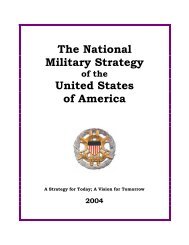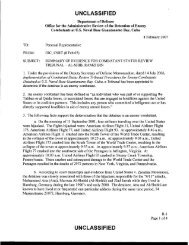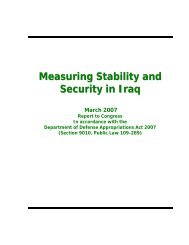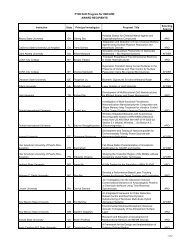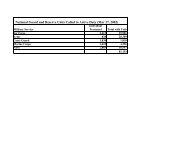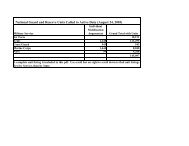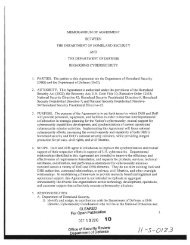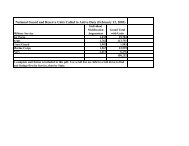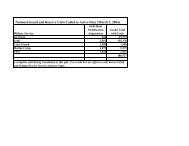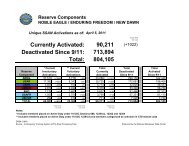Report - United States Department of Defense
Report - United States Department of Defense
Report - United States Department of Defense
You also want an ePaper? Increase the reach of your titles
YUMPU automatically turns print PDFs into web optimized ePapers that Google loves.
UNCLASSIFIED<br />
Renewed effort and attention, specifically in the ANSF recruiting process, is required to further<br />
reduce corruption in the security forces. Corruption and a lack <strong>of</strong> accountability in the<br />
recruitment process have resulted in the acceptance <strong>of</strong> recruits who should have been rejected on<br />
mental health or moral grounds. Reacting to the growing number <strong>of</strong> insider attacks, the Afghan<br />
government has begun to address defects in the ANSF recruiting process, though challenges still<br />
remain.<br />
2.2: SECURITY FORCE ASSISTANCE<br />
As the ANA develops, the main focus <strong>of</strong> SFA efforts shifts from the kandak level to the brigade<br />
level to the corps level to the region level. At SFA Level 1, the coalition unit continually advises<br />
and assists an ANSF unit on a daily basis, either from an embedded footprint or in close<br />
proximity. This model can also apply to partnering. SFATs that provide Level 1 contact will be<br />
supporting only one ANSF unit. Level 2 SFA refers to when a coalition unit advises and assists<br />
on a less frequent basis (determined by Commanders) to ensure the continued development <strong>of</strong><br />
the ANSF units. The frequency <strong>of</strong> this interaction varies depending on the proximity to the<br />
ANSF unit, the capability <strong>of</strong> the ANSF unit, threat, coalition resources and operational<br />
reach. SFATs that provide Level 2 contact may be supporting more than one ANSF unit. Level<br />
2 methodology will become the acceptable approach as ANA kandak (and later brigades) are<br />
assessed as “independent with advisors” and ready to assume the lead and full authority in their<br />
areas <strong>of</strong> responsibility.<br />
As <strong>of</strong> the end <strong>of</strong> the reporting period there was a shortfall <strong>of</strong> 60 SFATs, forcing ISAF to<br />
prioritize assigning the teams to certain key ANSF units. There are three major factors that<br />
impact the SFA coverage prioritization: threat to the ANSF and their ability to manage the<br />
violence and contain insurgency in their particular geographic area; the ability <strong>of</strong> ISAF to<br />
provide force protection and MEDEVAC in the area; and the development level <strong>of</strong> the ANSF<br />
itself. Due to lower threat and the dispersion <strong>of</strong> the ANSF units, there are more ANSF units in<br />
RC-N and RC-W operating autonomously than in RC-S, RC-E, and RC-SW. As ISAF continues<br />
to draw down SFAT coverage, there will be fewer than 200 SFA requirements by the end <strong>of</strong><br />
2013.<br />
The decision to provide SFA at different levels is a fluid process that is dependent on several<br />
factors. In several locations throughout Afghanistan, particularly in the north and west, SFA<br />
coverage has already shifted above the Brigade and Province level. Still, progress in some units<br />
lags due to threat level, fielding schedules, and other factors. Because <strong>of</strong> the fluidity and variance<br />
<strong>of</strong> development among Afghan units, the decision to transition SFA levels is <strong>of</strong>ten made at the<br />
regional command level and is a function <strong>of</strong> four major criteria:<br />
- Capability <strong>of</strong> ANSF units, as described by the readiness definition levels in the<br />
commander’s unit assessment tool (CUAT);<br />
- Threat/security assessment <strong>of</strong> the provinces and districts in the area;<br />
- Impact on campaign success (areas identified as key terrain districts); and<br />
- The stage <strong>of</strong> transition in the area.<br />
These data are collected and reviewed quarterly by the ISAF Joint Command Staff to ensure that<br />
milestones are being met and that development is progressing as desired. ISAF’s objective is to<br />
51



